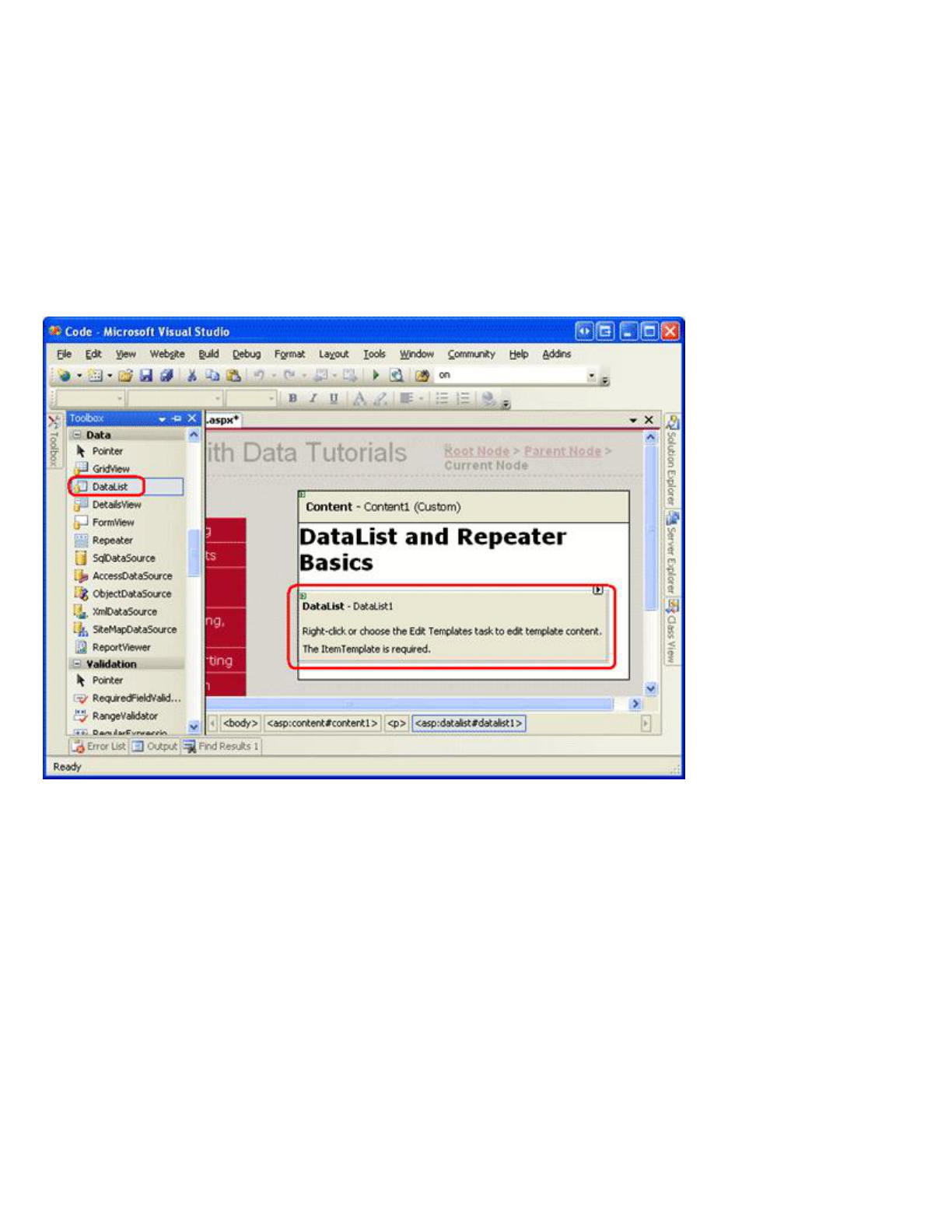
Thistutorialispartofaset.FindoutmoreaboutdataaccesswithASP.NETintheWorkingwithData
inASP.NET2.0sectionoftheASP.NETsiteathttp://www.asp.net/learn/dataaccess/default.aspx.
WorkingwithDatainASP.NE T2.0::Dis playing
DatawiththeDataListandRepeaterControls
Introduction
Inalloftheexamplesthroughoutthepast28tutorials,ifweneededtodisplaymultiplerecordsfromadatasource
weturnedtotheGridViewcontrol.TheGridViewrendersarowforeachrecordinthedatasource,displayingthe
record’sdatafieldsincolumns.WhiletheGridViewmakesitasnaptodisplay,pagethrough,sort,edit,anddelete
data,itsappearanceisabitboxy.Moreover,themarkupresponsiblefortheGridView’sstructureisfixed— it
includesanHTML
<table>
withatablerow(
<tr>
)foreachrecordandatablecell(
<td>
)foreachfield.
Toprovideagreaterdegreeofcustomizationintheappearanceandrenderedmarkupwhendisplayingmultiple
records,ASP.NET2.0offerstheDataListandRepeatercontrols(bothofwhichwerealsoavailableinASP.NET
version1.x).TheDataListandRepeatercontrolsrendertheircontentusingtemplatesratherthanBoundFields,
CheckBoxFields,ButtonFields,andsoon.LiketheGridView,theDataListrendersasanHTML
<table>
,but
allowsformultipledatasourcerecordstobedisplayedpertablerow.TheRepeater,ontheotherhand,rendersno
additionalmarkupthanwhatyouexplicitlyspecify,andisanidealcandidatewhenyouneedprecisecontrolover
themarkupemitted.
Overthenextdozenorsotutorials,we’lllookatbuildingcommonreportingpatternswiththeDataListand
Repeatercontrols,startingwiththebasicsofdisplayingdatawiththesecontrols’ templates.We’llseehowto
formatthesecontrols,howtoalterthelayoutofdatasourcerecordsintheDataList,commonmaster/details
scenarios,waystoeditanddeletedata,howtopagethroughrecords,andsoon.
Step1:AddingtheDataListandRepeaterTutorial
We bPages
Beforewestartthistutorial,let’sfirsttakeamomenttoaddtheASP.NETpageswe’llneedforthistutorialandthe
nextfewtutorialsdealingwithdisplayingdatausingtheDataListandRepeater.Startbycreatinganewfolderin
theprojectnamed
DataListRepeaterBasics
.Next,addthefollowingfiveASP.NETpagestothisfolder,having
allofthemconfiguredtousethemasterpage
Site.master
:
l
Default.aspx
l
Basics.aspx
l
Formatting.aspx
l
RepeatColumnAndDirection.aspx
l
NestedControls.aspx
1 of 19

Figure1:Createa
DataListRepeaterBasics
FolderandAddtheTutorialASP.NETPages
Openthe
Default.aspx
pageanddragthe
SectionLevelTutorialListing.ascx
UserControlfromthe
UserControls
folderontotheDesignsurface.ThisUserControl,whichwecreatedintheMasterPagesandSite
Navigation tutorial,enumeratesthesitemapanddisplaysthetutorialsfromthecurrentsectioninabulletedlist.
2 of 19

Figure2:Addthe
SectionLevelTutorialListing.ascx
UserControlto
Default.aspx
InordertohavethebulletedlistdisplaytheDataListandRepeatertutorialswe’llbecreating,weneedtoaddthem
tothesitemap.Openthe
Web.sitemap
fileandaddthefollowingmarkupafterthe“AddingCustomButtons” site
mapnodemarkup:
<siteMapNode
title="DisplayingDatawiththeDataListandRepeater"
description="SamplesofReportsthatUsetheDataListandRepeaterControls"
url="~/DataListRepeaterBasics/Default.aspx">
<siteMapNode
title="BasicExamples"
description="Examinesthebasicsfordisplayingdatausingthe
DataListandRepeatercontrols."
url="~/DataListRepeaterBasics/Basics.aspx"/>
<siteMapNode
title="Formatting"
description="LearnhowtoformattheDataListandtheWebcontrolswithin
theDataListandRepeater'stemplates."
url="~/DataListRepeaterBasics/Formatting.aspx"/>
<siteMapNode
title="AdjustingtheDataList&apos;sLayout"
description="IllustrateshowtoaltertheDataList'slayout,showing
multipledatasourcerecordspertablerow."
url="~/DataListRepeaterBasics/RepeatColumnAndDirection.aspx"/>
<siteMapNode
title="NestingaRepeaterwithinaDataList"
description="LearnhowtonestaRepeaterwithinthetemplateofaDataList."
url="~/DataListRepeaterBasics/NestedControls.aspx"/>
</siteMapNode>
3 of 19

Figure3:UpdatetheSiteMaptoIncludetheNewASP.NETPages
Step2:DisplayingProdu ctInformationwi ththe
DataList
SimilartotheFormView,theDataListcontrol’srenderedoutputdependsupontemplatesratherthanBoundFields,
CheckBoxFields,andsoon.UnliketheFormView,theDataListisdesignedtodisplayasetofrecordsratherthana
solitaryone.Let’sbeginthistutorialwithalookatbindingproductinformationtoaDataList.Startbyopeningthe
Basics.aspx
pageinthe
DataListRepeaterBasics
folder.Next,dragaDataListfromtheToolboxontothe
Designer.AsFigure4illustrates,beforespecifyingtheDataList’stemplates,theDesignerdisplaysitasagraybox.
Figure4:DragtheDataListFromtheToolboxOntotheDesigner
FromtheDataList’ssmarttag,addanewO bjectDataSourceandconfigureittousethe
ProductsBLL
class’s
GetProducts
method.Sincewe’recreatingareadonlyDataListinthistutorial,setthedropdownlistto(None)in
thewizard’sINSERT,UPD ATE,andDELETEtabs.
4 of 19

Figure5:OpttoCreateaNewObjectDataSource
Figure6:ConfiguretheObjectDataSourcetoUsethe
ProductsBLL
Class
5 of 19

Figure7:RetrieveInformationAboutAlloftheProductsUsingthe
GetProducts
Method
AfterconfiguringtheObjectDataSourceandassociatingitwiththeDataListthroughitssmarttag,VisualStudio
willautomaticallycreatean
ItemTemplate
intheDataListthatdisplaysthenameandvalueofeachdatafield
returnedbythedatasource(seethemarkupbelow).Thisdefault
ItemTemplate
’sappearanceisidenticaltothatof
thetemplatesautomaticallycreatedwhenbindingadatasourcetotheFormViewthroughtheDesigner.
<asp:DataListID="DataList1"runat="server"DataKeyField="ProductID"
DataSourceID="ObjectDataSource1"EnableViewState="False">
<ItemTemplate>
ProductID:<asp:LabelID="ProductIDLabel"runat="server"
Text='<%#Eval("ProductID")%>'/><br/>
ProductName:<asp:LabelID="ProductNameLabel"runat="server"
Text='<%#Eval("ProductName")%>'/><br/>
SupplierID:<asp:LabelID="SupplierIDLabel"runat="server"
Text='<%#Eval("SupplierID")%>'/><br/>
CategoryID:<asp:LabelID="CategoryIDLabel"runat="server"
Text='<%#Eval("CategoryID")%>'/><br/>
QuantityPerUnit:<asp:LabelID="QuantityPerUnitLabel"runat="server"
Text='<%#Eval("QuantityPerUnit")%>'/><br/>
UnitPrice:<asp:LabelID="UnitPriceLabel"runat="server"
Text='<%#Eval("UnitPrice")%>'/><br/>
UnitsInStock:<asp:LabelID="UnitsInStockLabel"runat="server"
Text='<%#Eval("UnitsInStock")%>'/><br/>
UnitsOnOrder:<asp:LabelID="UnitsOnOrderLabel"runat="server"
Text='<%#Eval("UnitsOnOrder")%>'/><br/>
ReorderLevel:<asp:LabelID="ReorderLevelLabel"runat="server"
Text='<%#Eval("ReorderLevel")%>'/><br/>
Discontinued:<asp:LabelID="DiscontinuedLabel"runat="server"
Text='<%#Eval("Discontinued")%>'/><br/>
CategoryName:<asp:LabelID="CategoryNameLabel"runat="server"
Text='<%#Eval("CategoryName")%>'/><br/>
SupplierName:<asp:LabelID="SupplierNameLabel"runat="server"
Text='<%#Eval("SupplierName")%>'/><br/>
6 of 19

<br/>
</ItemTemplate>
</asp:DataList>
<asp:ObjectDataSourceID="ObjectDataSource1"runat="server"
OldValuesParameterFormatString="original_{0}"
SelectMethod="GetProducts"TypeName="ProductsBLL">
</asp:ObjectDataSource>
Note:
RecallthatwhenbindingadatasourcetoaFormViewcontrolthroughtheFormView’ssmart tag,Visual
Studiocreatedan
ItemTemplate
,
InsertItemTemplate
,and
EditItemTemplate
.WiththeDataList,however,
onlyan
ItemTemplate
iscreated.ThisisbecausetheDataListdoesnothavethesamebuiltineditingandinserting
supportofferedbytheFormView.TheDataListdoescontainedit anddeleterelatedevents,andeditingand
deletingsupportcanbeaddedwithabitofcode,butthere’snosimpleoutoftheboxsupportaswiththe
FormView.We’llseehowtoincludeeditinganddeletingsupportwiththeDataListinafuturetutorial.
Let’stakeamomenttoimprovetheappearanceofthistemplate.Ratherthandisplayingallofthedatafields,let’s
onlydisplaytheproduct’sname,supplier,category,quantity perunit,andunitprice.Moreover,let’sdisplaythe
nameinan
<h4>
headingandlayouttheremainingfieldsusinga
<table>
beneaththeheading.
TomakethesechangesyoucaneitherusethetemplateeditingfeaturesintheDesigner — fromtheDataList’s
smarttagclickontheEditTemplateslink— oryoucanmodifythetemplatemanuallythroughthepage’s
declarativesyntax.IfyouusetheEditTemplatesoptionintheDesigner,yourresultingmarkupmaynotmatchthe
followingmarkupexactly,butwhenviewedthroughabrowsershouldlookverysimilartothescreenshotshownin
Figure8.
<asp:DataListID="DataList1"runat="server"DataKeyField="ProductID"
DataSourceID="ObjectDataSource1"EnableViewState="False">
<ItemTemplate>
<h4><asp:LabelID="ProductNameLabel"runat="server"
Text='<%#Eval("ProductName")%>'/></h4>
<tableborder="0">
<tr>
<tdclass="ProductPropertyLabel">Category:</td>
<td><asp:LabelID="CategoryNameLabel"runat="server"
Text='<%#Eval("CategoryName")%>'/></td>
<tdclass="ProductPropertyLabel">Supplier:</td>
<td><asp:LabelID="SupplierNameLabel"runat="server"
Text='<%#Eval("SupplierName")%>'/></td>
</tr>
<tr>
<tdclass="ProductPropertyLabel">Qty/Unit:</td>
<td><asp:LabelID="QuantityPerUnitLabel"runat="server"
Text='<%#Eval("QuantityPerUnit")%>'/></td>
<tdclass="ProductPropertyLabel">Price:</td>
<td><asp:LabelID="UnitPriceLabel"runat="server"
Text='<%#Eval("UnitPrice","{0:C}")%>'/></td>
</tr>
</table>
</ItemTemplate>
</asp:DataList>
Note:
TheexampleaboveusesLabelWebcontrolswhose
Text
propertyisassignedthevalueofthedatabinding
syntax.Alternatively,wecouldhaveomittedtheLabelsaltogether,typinginjustthedatabindingsyntax.Thatis,
insteadofusing
<asp:LabelID="CategoryNameLabel"runat="server"Text='<%#Eval("CategoryName")
%>'/>
wecouldhaveinsteadusedthedeclarativesyntax
<%#Eval("CategoryName")%>
.
LeavingintheLabelWebcontrols,however,offertwoadvantages.First,itprovidesaneasiermeansforformatting
thedatabasedonthedata,aswe’llseeinthenexttutorial.Second,theEditTemplatesoptionintheDesigner
doesn’tdisplaydeclarativedatabindingsyntaxtha tappearsouts ideofsomeWebcontrol.Instead,theEdit
7 of 19

TemplatesinterfaceisdesignedtofacilitateworkingwithstaticmarkupandWebcontrolsandassumesthatany
databindingwillbedonethroughtheEditDataBindingsdialogbox,whichisaccessiblefromtheWebcontrols’
smarttags.
Therefore,whenworkingwiththeDataList,whichprovidestheoptionofeditingthetemplatesthroughthe
Designer,IprefertouseLabelWebcontrolssothatthecontentisaccessiblethroughtheEditTemplatesinterface.
Aswe’llseeshortly,theRepeaterrequiresthatthetemplate’scontentsbeeditedfromtheSourceview.
Consequently,whencraftingtheRepeater’stemplatesI’lloftenomittheLabelWebcontrolsunlessIknowI’ll
needtoformattheappearanceofthedataboundtextbasedonprogrammaticlogic.
Figure8:EachProduct’sOutputisRenderedUsingtheDataList’s
ItemTemplate
Step3:Im provingtheAppearanceoft heDataList
LiketheGridView,theDataListoffersanumberofstylerelatedproperties,suchas
Font
,
ForeColor
,
BackColor
,
CssClass
,
ItemStyle
,
AlternatingItemStyle
,
SelectedItemStyle
,andsoon.Whenworkingwiththe
GridViewandDetailsViewcontrols,wecreatedSkinfilesinthe
DataWebControls
Themethatpredefinedthe
CssClass
propertiesforthesetwocontrolsandthe
CssClass
propertyforseveraloftheirsubproperties
(
RowStyle
,
HeaderStyle
,andsoon).Let’sdothesamefortheDataList.
AsdiscussedintheDisplayingDataW iththeObjectDataSourcetutorial,aSkinfilespecifiesthedefault
appearancerelatedpropertiesforaWebcontrol;aThemeisacollectionofSkin,CSS,image,andJavaScriptfiles
thatdefineaparticularlookandfeelforawebsite.IntheDisplayingDataWiththeObjectDataSourc e tutorial,we
createda
DataWebControls
Theme(whichisimplementedasafolderwithinthe
App_Themes
folder)thathas,
currently,twoSkinfiles
GridView.skin
and
DetailsView.skin
.Let’saddathirdSkinfiletospecifythepre
8 of 19

definedstylesettingsfortheDataList.
ToaddaSkinfile,rightclickonthe
App_Themes/DataWebControls
folder,chooseAddaNewItem,andselect
theSkinFileoptionfromthelist.Namethefile
DataList.skin
.
Figure9:CreateaNewSkinFileNamed
DataList.skin
Usethefollowingmarkupforthe
DataList.skin
file:
<asp:DataListrunat="server"CssClass="DataWebControlStyle">
<AlternatingItemStyleCssClass="AlternatingRowStyle"/>
<ItemStyleCssClass="RowStyle"/>
<HeaderStyleCssClass="HeaderStyle"/>
<FooterStyleCssClass="FooterStyle"/>
<SelectedItemStyleCssClass="SelectedRowStyle"/>
</asp:DataList>
ThesesettingsassignthesameCSSclassestotheappropriateDataListpropertiesaswereusedwiththeGridView
andDetailsViewcontrols.TheCSSclassesusedhere—
DataWebControlStyle
,
AlternatingRowStyle
,
RowStyle
,andsoon— aredefinedinthe
Styles.css
fileandwereaddedinprevioustutorials.
WiththeadditionofthisSkinfile,theDataList’sappearanceisupdatedintheDesigner(youmayneedtorefresh
theDesignerviewtoseetheeffectsofthenewSkinfile;fromtheViewmenu,chooseRefresh).AsFigure10
shows,eachalternatingproducthasalightpinkbackgroundcolor.
9 of 19

Figure10:CreateaNewSkinFileNamed
DataList.skin
Step4:ExploringtheDataList’sOtherTemplates
Inadditiontothe
ItemTemplate
,theDataListsupportssixotheroptionaltemplates:
l
HeaderTemplate
—ifprovided,addsaheaderrowtotheoutputandisusedtorenderthisrow
l
AlternatingItemTemplate
—usedtorenderalternatingitems
l
SelectedItemTemplate
—usedtorendertheselecteditem;theselecteditemistheitemwhoseindex
correspondstotheDataList’s
SelectedIndex
property
l
EditItemTemplate
—usedtorendertheitembeingedited
l
SeparatorTemplate
—ifprovided,addsaseparatorbetweeneachitemandisusedtorenderthisseparator
l
FooterTemplate
ifprovided,addsafooterrowtotheoutputandisusedtorenderthisrow
10 of 19

Whenspecifyingthe
HeaderTemplate
or
FooterTemplate
,theDataListaddsanadditionalheaderorfooterrowto
therenderedoutput.LikewiththeGridView’sheaderandfooterrows,theheaderandfooterinaDataListarenot
boundtodata.Therefore,anydatabindingsyntaxinthe
HeaderTemplate
or
FooterTemplate
thatattemptsto
accessbounddatawillreturnablankstring.
Note:
AswesawintheDisplayingSummaryInformationintheGridView’ sFooter tutorial,whiletheheaderand
footerrowsdon’tsupportdatabindingsyntax,dataspecificinformationcanbeinjecteddirectlyintotheserows
fromtheGridView’s
RowDataBound
eventhandler.Thistechniquecanbeusedtobothcalculaterunningtotalsor
otherinformationfromthedataboundtothecontrolaswellasassignthatinformationtothefooter.Thissame
conceptcanbeappliedtotheDataListandRepeatercontrols;theonlydifferenceisthatfortheDataListand
Repeatercreateaneventhandlerforthe
ItemDataBound
event(insteadofforthe
RowDataBound
event).
Forourexample,let’shavethetitle“ProductInformation” displayedatthetopoftheDataList’sresultsinan
<h3>
heading.Toaccomplishthis,adda
HeaderTemplate
withtheappropriatemarkup.FromtheDesigner,thiscanbe
accomplishedbyclickingontheEditTemplateslinkintheDataList’ssmarttag,choosingtheHeaderTemplate
fromthedropdownlist,andtypinginthetextafterpickingtheHeading3optionfromthestyledropdownlist(see
Figure11).
Figure11:Adda
HeaderTemplate
withtheText “ProductInformation”
Alternatively,thiscanbeaddeddeclarativelybyenteringthefollowingmarkupwithinthe
<asp:DataList>
tags:
<HeaderTemplate>
<h3>ProductInformation</h3>
</HeaderTemplate>
Toaddabitofspacebetweeneachproductlisting,let’sadda
SeparatorTemplate
thatincludesalinebetween
eachsection.Thehorizontalruletag(
<hr>
),addssuchadivider.Createthe
SeparatorTemplate
sothatithasthe
followingmarkup:
<SeparatorTemplate>
<hr/>
</SeparatorTemplate>
11 of 19

Note:
Likethe
HeaderTemplate
and
FooterTemplates
,the
SeparatorTemplate
isnotboundtoanyrecordfrom
thedatasourceandthereforecannotdirectlyaccessthedatasourcerecordsboundtotheDataList.
Aftermakingthisaddition,whenviewingthepagethroughabrowseritshouldlooksimilartoFigure12.Notethe
headerrowandthelinebetweeneachproductlisting.
Figure12:TheDataListIncludesaHeaderRowandaHorizontalRuleBetweenEachProductListing
Step5:RenderingSpecificM ar kupwit htheRepea ter
Contro l
IfyoudoaView/SourcefromyourbrowserwhenvisitingtheDataListexamplefromFigure12,you’llseethatthe
DataListemitsanHTML
<table>
thatcontainsatablerow(
<tr>
)withasingletablecell(
<td>
)foreachitem
boundtotheDataList.Thisoutput,infact,isidenticaltowhatwouldbeemittedfromaGridViewwithasingle
TemplateField.Aswe’llseeinafuturetutorial,theDataListdoesallowfurthercustomizationoftheoutput,
enablingustodisplaymultipledatasourcerecordspertablerow.
Whatifyoudon’twanttoemitanHTML
<table>
,though?Fortotalandcompletecontroloverthemarkup
generatedbyadataWebcontrol,wemustusetheRepeatercontrol.LiketheDataList,theRepeaterisconstructed
basedupontemplates.TheRepeater,however,onlyoffersthefollowingfivetemplates:
l
HeaderTemplate
—ifprovided,addsthespecifiedmarkupbeforetheitems
l
ItemTemplate
—usedtorenderitems
12 of 19

l
AlternatingItemTemplate
—ifprovided,usedtorenderalternatingitems
l
SeparatorTemplate
—ifprovided,addsthespecifiedmarkupbetweeneachitem
l
FooterTemplate
ifprovided,addsthespecifiedmarkupaftertheitems
InASP.NET1.x,theRepeatercontrolwascommonlyusedtodisplayabulletedlistwhosedatacamefromsome
datasource.Insuchacase,the
HeaderTemplate
and
FooterTemplates
wouldcontaintheopeningandclosing
<ul>
tags,respectively,whilethe
ItemTemplate
wouldcontain
<li>
elementswithdatabindingsyntax.This
approachcanstillbeusedinASP.NET2.0aswesawintwoexamplesintheMasterPagesandSiteNavigation
tutorial:
l
Inthe
Site.master
masterpage,aRepeaterwasusedtodisplayabulletedlistofthetoplevelsite map
contents(BasicReporting,FilteringReports,CustomizedFormatting,andsoon);another,nestedRepeater
wasusedtodisplaythechildrensectionsofthetoplevelsections
l
In
SectionLevelTutorialListing.ascx
,aRepeaterwasusedtodisplayabulletedlistofthechildren
sectionsofthecurrentsitemapsection
Note:
ASP.NET2.0introducesthenewBulletedListcontrol,whichcanbeboundtoadatasourcecontrolinorder
todisplayasimplebulletedlist.WiththeBulletedListcontrolwedonotneedtospecifyanyofthelistrelated
HTML;instead,wesimplyindicatethedatafieldtodisplayasthetextforeachlistitem.
TheRepeaterservesasa “catchall” dataWebcontrol.Ifthereisnotanexistingcontrolthatgeneratestheneeded
markup,theRepeatercontrolcanbeused.ToillustrateusingtheRepeater,let’shavethelistofcategories
displayedabovetheProductInformationDataListcreatedinStep2.Inparticular,let’shavethecategories
displayedinasinglerowHTML
<table>
witheachcategorydisplayedasacolumninthetable.
Toaccomplishthis,startbydraggingaRepeatercontrolfromtheToolboxontotheDesigner,abovetheProduct
InformationDataList.AswiththeDataList,theRepeaterinitiallydisplaysasagrayboxuntilitstemplateshave
beendefined.
13 of 19

Figure13:AddaRepeatertotheDesigner
There’sonlyoneoptionintheRepeater’ssmarttag:ChooseDataSour ce.OpttocreateanewObjectDataSource
andconfigureittousethe
CategoriesBLL
class’s
GetCategories
method.
14 of 19

Figure14:CreateaNewObjectDataSource
Figure15:ConfiguretheObjectDataSourcetoUsethe
CategoriesBLL
Class
15 of 19

Figure16:RetrieveInformationAboutAlloftheCategoriesUsingthe
GetCategories
Method
UnliketheDataList,VisualStudiodoesnotautomaticallycreateanItemTemplatefortheRepeaterafterbindingit
toadatasource.Furthermore,theRepeater’stemplatescannotbeconfiguredthroughtheDesignerandmustbe
specifieddeclaratively.
Todisplaythecategoriesasasinglerow
<table>
withacolumnforeachcategory,weneedtheRepeatertoemit
markupsimilartothefollowing:
<table>
<tr>
<td>Category1</td>
<td>Category2</td>
...
<td>CategoryN</td>
</tr>
</table>
Sincethe
<td>
CategoryX
</td>
textistheportionthatrepeats,thiswillappearintheRepeater’sItemTemplate.
Themarkupthatappearsbeforeit
<table><tr>
willbeplacedinthe
HeaderTemplate
whiletheendingmarkup
</tr></table>
willplacedinthe
FooterTemplate
.Toenterthesetemplatesettings,gotothedeclarative
portionoftheASP.NETpagebyclickingontheSourcebuttoninthelowerleftcornerandtypeinthefollowing
syntax:
<asp:RepeaterID="Repeater1"runat="server"DataSourceID="ObjectDataSource2"
EnableViewState="False">
<HeaderTemplate>
<table>
<tr>
</HeaderTemplate>
<ItemTemplate>
<td><%#Eval("CategoryName")%></td>
16 of 19

</ItemTemplate>
<FooterTemplate>
</tr>
</table>
</FooterTemplate>
</asp:Repeater>
TheRepeateremitstheprecisemarkupasspecifiedbyitstemplates,nothingmore,nothingless.Figure17shows
theRepeater’soutputwhenviewedthroughabrowser.
Figure17:ASingleRowHTML
<table>
ListsEachCategoryinaSeparateColumn
Step6:Im provingtheAppearanceoft heRepeater
SincetheRepeateremitspreciselythemarkupspecifiedbyitstemplates,itshouldcomeasnosurprisethatthere
arenostylerelatedpropertiesfortheRepeater.ToaltertheappearanceofthecontentgeneratedbytheRepeater,
wemustmanuallyaddtheneededHTMLorCSScontentdirectlytotheRepeater’stemplates.
Forourexample,let’shavethecategory columns alternatebackgroundcolors,likewiththealternating rowsinthe
DataList.Toaccomplishthis,weneedtoassignthe
RowStyle
CSSclasstoeachRepeateritemandthe
AlternatingRowStyle
CSSclasstoeachalternatingRepeateritemthroughthe
ItemTemplate
and
AlternatingItemTemplate
templates,likeso:
<ItemTemplate>
<tdclass="RowStyle"><%#Eval("CategoryName")%></td>
</ItemTemplate>
<AlternatingItemTemplate>
<tdclass="AlternatingRowStyle"><%#Eval("CategoryName")%></td>
</AlternatingItemTemplate>
Let’salsoaddaheaderrowtotheoutputwiththetext“ProductCategories”. Sincewedon’tknowhowmany
columnsourresulting
<table>
willbecomprisedof,thesimplestwaytogenerateaheaderrowthatisguaranteed
tospanallcolumnsistousetwo
<table>
s.Thefirst
<table>
willcontaintworows— theheaderrowandarow
thatwillcontainthesecond,singlerow
<table>
thathasacolumnforeachcategoryinthesystem.Thatis,we
wanttoemitthefollowingmarkup:
<table>
<tr>
<th>ProductCategories</th>
17 of 19

</tr>
<tr>
<td>
<table>
<tr>
<td>Category1</td>
<td>Category2</td>
...
<td>CategoryN</td>
</tr>
</table>
</td>
</tr>
</table>
Thefollowing
HeaderTemplate
and
FooterTemplate
resultinthedesiredmarkup:
<asp:RepeaterID="Repeater1"runat="server"DataSourceID="ObjectDataSource2"
EnableViewState="False">
<HeaderTemplate>
<tablecellpadding="0"cellspacing="0"style="border:solid1pxblack;">
<tr>
<thclass="HeaderStyle">ProductCategories</th>
</tr>
<tr>
<td>
<tablecellpadding="4"cellspacing="0">
<tr>
</HeaderTemplate>
<ItemTemplate>
<tdclass="RowStyle"><%#Eval("CategoryName")%></td>
</ItemTemplate>
<AlternatingItemTemplate>
<tdclass="AlternatingRowStyle">
<%#Eval("CategoryName")%></td>
</AlternatingItemTemplate>
<FooterTemplate>
</tr>
</table>
</td>
</tr>
</table>
</FooterTemplate>
</asp:Repeater>
Figure18showstheRepeaterafterthesechangeshavebeenmade.
18 of 19

Figure18:TheCategoryColumnsAlternateinBackgroundColorandIncludesaHeaderRow
Summary
WhiletheGridViewcontrolmakesiteasytodisplay,edit,delete,sort,andpagethroughdata,theappearanceis
veryboxyandgridlike.Formorecontrolovertheappearance,weneedtoturntoeithertheDataListorRepeater
controls.BothofthesecontrolsdisplayasetofrecordsusingtemplatesinsteadofBoundFields,CheckBoxFields,
andsoon.
TheDataListrendersasanHTML
<table>
that,bydefault,displayseachdatasourcerecordinasingletablerow,
justlikeaGridViewwithasingleTemplateField.Aswewillseeinafuturetutorial,however,theDataListdoes
permitmultiplerecordstobedisplayedpertablerow.TheRepeater,ontheotherhand,strictlyemitsthemarkup
specifiedinitstemplates;itdoesnotaddanyadditionalmarkupandthereforeiscommonlyusedtodisplaydatain
HTMLelementsotherthana
<table>
(suchasinabulletedlist).
WhiletheDataListandRepeateroffermoreflexibilityintheirrenderedoutput,theylackmanyofthebuiltin
featuresfoundintheGridView.Aswe’llexamineinupcomingtutorials,someofthesefeaturescanbeplugged
backinwithouttoomucheffort,butdokeepinmindthatusingtheDataListorRepeaterinlieuoftheGridView
doeslimitthefeaturesyoucanusewithouthavingtoimplementthosefeaturesyourself.
HappyProgramming!
AbouttheAuthor
ScottMitchell,authorofsixASP/ASP.NETbooksandfounderof 4GuysFromRolla.com,hasbeenworkingwith
MicrosoftWebtechnologiessince1998.Scottworksasanindependentconsultant,trainer,andwriter,recently
completinghislatestbook, SamsTeachYourselfASP.NET2.0in24Hours.Hecanbereachedat
SpecialTha nksTo…
Thistutorialserieswasreviewedbymanyhelpfulreviewers.LeadreviewersforthistutorialincludeYaakovEllis,
LizShulok,RandySchmidt,andStacyPark.Interestedinreviewingmyupcomingarticles?Ifso,dropmealineat
19 of 19
